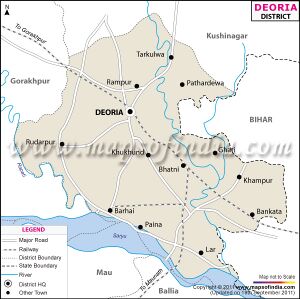Deoria
| Author:Laxman Burdak, IFS (R) |

Deoria (देवरिया) is a city and district of Uttar Pradesh, India.
Origin
The Deoria district came into existence on March 16, 1946, being separated from the Gorakhpur District. It is believed that the name Deoria is derived from Devaranya or possibly Devapuria. According to official gazetteers, the district was named "Deoria" after its headquarters in Deoria, and the term Deoria generally means a place where there are temples. The name Deoria probably developed because of the existence of important temples in the area.
Variants
Deoria (देओरिया) (जिला इलाहाबाद, उ.प्र.) (AS, p.440)
History
The area now known as the Deoria District was once a part of the Kosala Kingdom - a prime centre of ancient Aryan culture surrounded by the Himalayas in the north, the Shyandika river in the south, the Panchala Kingdom in the west and the Magadha Kingdom in Bihar to the east. Apart from the many legends told about this area, archaeological remains, such as statues, coins, bricks, temples, and Buddhist Maths, have been discovered at many locations in this district, showing that there was a developed and organised society long ago.
The ancient history of the district is related with the Ramayana times when the Lord of Kosala, Rama, appointed his elder son Kusha the king of Kushawati, which is present-day Kushinagar. Before the Mahabharata era, this area had been related with Chakravorty Samrat Mahasudtsan Mall and his kingdom. Kushinagar was well developed and prosperous. Close to the border of his kingdom was the thick forested area called the Mahavan. This area was under the control of the Maurya rulers, the Gupta rulers, the Bihar rulers, and then the Garhwal ruler Govinda Chandra from 1114 AD until 1154 AD.
देओरिया
विजयेन्द्र कुमार माथुर[1] ने लेख किया है ... देओरिया (AS, p.440): देओरिया इलाहाबाद ज़िला, उत्तर प्रदेश का एक ऐतिहासिक स्थान है। 5वीं शती ई. का एक गुप्त कालीन मूर्ति अभिलेख इस स्थान से प्राप्त हुआ है। गुप्त कालीन वह मूर्ति अभिलेख लखनऊ के संग्रहालय में सुरक्षित है। इस अभिलेख में शाक्य भिक्षु बोधिवर्मन द्वारा एक बौद्ध प्रतिमा की प्रतिष्ठापना का उल्लेख है। अभिलेख में जो लेख है, वह मूर्ति के अधरतल पर अंकित है।
ककुभग्राम
विजयेन्द्र कुमार माथुर[2] ने लेख किया है ... ककुभग्राम (AS, p.124) उत्तर प्रदेश राज्य के देवरिया ज़िला में स्थित था। ककुभग्राम में गुप्तवंशीय महाराजाधिराज स्कन्दगुप्त के समय (गुप्तसंवत् 141-460 ई.) का एक स्तंभ-लेख प्राप्त हुआ था। यह जैन अभिलेख है जिसे भद्र नामक व्यक्ति ने जैन तीर्थंकरों की मूर्तियों की प्रतिष्ठापना के लिए कुकुभग्राम-वर्तमान कहौम में अंकित करवाया था। ये आदिकर्तृ अथवा तीर्थकरों की प्रतिमाएँ अभिलेख वाले स्तंभ पर उकेरी हुई हैं। स्तंभ के निकट एक ताल है जहाँ सात फुट ऊँची बुद्ध की मूर्ति स्थित थी।
In Mahabharata
Deva-vana (देव वन) (Forest)/(Tirtha) (III.85.21)
Vana Parva, Mahabharata/Book III Chapter 85 mentions sacred asylums, tirthas, mountans and regions of eastern country. Devavana (देववन) (Forest)/(Tirtha) is mentioned in Mahabharata (III.85.21). [3]
External links
References
- ↑ Aitihasik Sthanavali by Vijayendra Kumar Mathur, p.440
- ↑ Aitihasik Sthanavali by Vijayendra Kumar Mathur, p.124
- ↑ यत्र देव वनं रम्यं तापसैर उपशॊभितम, बाहुदा च नदी यत्र नन्दा च गिरिमूर्धनि (III.85.21)

